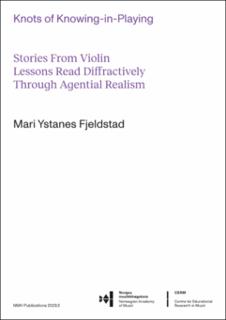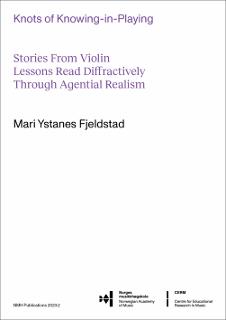| dc.contributor.author | Fjeldstad, Mari Ystanes | |
| dc.date.accessioned | 2023-05-03T14:50:54Z | |
| dc.date.available | 2023-05-03T14:50:54Z | |
| dc.date.issued | 2023 | |
| dc.identifier.isbn | 978-82-7853-317-8 (print) | |
| dc.identifier.isbn | 978-82-7853-318-5 (online) | |
| dc.identifier.issn | 0333-3760 | |
| dc.identifier.issn | 2535-373X (online) | |
| dc.identifier.uri | https://hdl.handle.net/11250/3066050 | |
| dc.description | Dissertation for the PhD degree Norwegian Academy of Music, Oslo 2023 - Avhandling (Ph.D.) - Norges musikkhøgskole, Oslo 2023 | en_US |
| dc.description.abstract | Samandrag -
Denne feministiske ny-materielle og posthumanistiske studien utforskar praksisen i norske kulturskolar gjennom intervju med tre fiolinlærarar og observasjon av undervisninga deira. Det finst forsking som undersøker diskursane i rammeplanen til kulturskolen. Det finst også studiar som undersøker synspunkta til lærarar og leiarar gjennom intervju og spørjeskjema.
Denne studien utfyller desse og bidrar til ei breiare forståing av praksisen i kulturskolen gjennom å også undersøke det uventa og materielle, til dømes klistremerke som fell av fiolinar, edderkoppar som forstyrrar undervisninga, og elevar som kjem for seint og utan å ha med seg fiolinen. Utgangspunktet for studien er ei interesse for korleis fiolintimar speler seg ut og for kva som vert skapt gjennom dei.
Det teoretiske rammeverket eg brukar er agentisk realisme, ein filosofi utvikla av Karen Barad. Agentisk realisme bygger på kunnskap frå kvantefysikk, poststrukturalisme, postkolonialisme og feminisme. Teorien ser på etikk, ontologi og epistemologi som samanfiltra, den har eit performativt verdssyn der verda vert til gjennom intra-aksjonar, og den forstår aktørskap som noko som vert gjort heller enn som ein eigenskap knytt til menneske og våre intensjonar. I denne studien vert agentisk realisme utvida ved at den vert lesen gjennom samiske studiar, interseksjonell feminisme og affektteori.
Eg har gjennomført intervju med tre fiolinlærarar og observert undervisning med 2 til 7 av elevane deira i periodar på 5 til 6 veker. På grunn av koronapandemien, vart ein av periodane med observasjon gjennomført digitalt. Intervjua og observasjonane er, saman med dagboknotatar og notar, skrive om til historier. Desse historiene er inspirert av feministiske og samiske historietradisjonar. I staden for å vere framstillingar som representerer det som skjedde på fiolintimane, er historiene diffraktive historier som vert lest og lest igjen, fortalt og gjenfortalt, saman gjennom teoriar. Dette skapar rike og nyanserte forståingar av handlingane og aktørane som konstituerer fiolintimar.
Gjennom den diffraktive lesinga av historier og teori oppstod fire konsept. Det fyrste konseptet er topologisk fellesskap. Gjennom ei lesing av historier frå fiolintimar og den agentisk realistiske forståinga av tid og rom, utviklar eg ei topologisk forståing av korleis tida og rommet for fiolintimar vert til gjennom intra-aksjonar. Dette utfyller ei geometrisk oppfatning av tid og rom der rammene for fiolintimen er noko som eksisterer før sjølve timen.
Det andre konseptet som oppstod er tentakulære og agentiske fiolinar. Med utgangspunkt i min eigen fiolin følgjer eg trådane som knyt den til fiolinmakarar, -lærarar og -elevar, til kapitalistiske og koloniale strukturar, og til dei kjønna strukturane som eksisterer i vestleg, klassisk musikk. Deretter tar eg utgangspunkt i fiolinane frå fiolintimane eg observerte, og eg utforskar korleis dei er aktørar som tar del i handlingane i timen. Gjennom å undersøke fiolinar som tentakulære og agentiske, utviklar eg kunnskap om korleis fiolintimar speler seg ut og om kva rolle andre aktørane enn menneske speler i dei.
Det tredje konseptet som oppstod gjennom den diffraktive lesinga er ulike tilbliingar. Gjennom å lese av historier frå fiolintimar saman gjennom interseksjonell feminisme og agentisk realisme vert u/moglegheitene for å bli fiolinistar synlege. Desse u/moglegheitene er ikkje tilfeldige, men knytt til etnisitet, klasse og kjønn, og til samspelet mellom desse kategoriane. Å undersøke korleis fiolintimar skapar ulike moglegheiter for ulike elevar bidrar til kunnskap om inkludering og ekskludering i kulturskolen.
Det fjerde konseptet som oppstod, og som bygger på dei tre andre, er knutar av kunnskap-i-spel. Det er eit konsept som rettar merksemda mot dei samanfiltra materielle, diskursive og affektive aspekta ved fiolintimar, og mot korleis fiolintimar spelar seg ut gjennom intra-aksjonar. Denne studien utviklar kunnskap om fiolinundervisning i kulturskolen. Den er også eit eksempel på dei moglegheitene som oppstår i møtet mellom feministisk ny-materiell og posthumanistisk teori og musikkpedagogisk forsking. Eg argumenterer for at desse teoriane tilbyr moglegheiter for å skape forsking og styringsdokument som er nærare knytt til undervisningskvardagen i kulturskolen. Dette kan vere med på å førebu framtidige lærarar betre på den komplekse verkelegheita dei vil møte. Teoriane kan også bidra til musikkpedagogisk forsking som skaper betre innsikt i dei ulike tilbliingane som er tilgjengelege for ulike elevar, og dermed bidra til å skape meir inkluderande musikkpedagogiske praksisar. | en_US |
| dc.description.abstract | Summary -
This feminist new materialist and posthuman inquiry explores violin lessons held by three teachers and their students in Norwegian schools of music and performing arts (SMPA). In current research related to the Nordic field of SMPA, there is rich literature drawing on discourse analysis of policy documents and on interviews and surveys of leaders and teachers. This inquiry develops a broader insight into SMPA music education practices by also taking an interest in the mess and the matter of violin lessons: in the stickers falling off the fingerboard of the violins, the spiders interrupting the lessons, and the students coming late and without violins. The initial question guiding this inquiry is: How are violin lessons enacted and what do they produce?
The main theoretical framework of this inquiry is Karen Barad’s agential realism. Barad builds their philosophy on reading insights from poststructuralism, critical social theories, and quantum physics through one another. Agential realism argues for the entanglement of knowing and being, for a performative worldview where the world is becoming through intra-actions rather than being constituted by pre-existing entities (realism) or becoming through social constructions (constructivism), and for an understanding of agency as not aligned with human intentionality. In this inquiry, agential realism is expanded by being read through Sámi studies, intersectional feminism, and affect theory.
The inquiry is a postqualitative inquiry that takes a thorough reading of theory as a starting point for developing research practices. I have intra-viewed three violin teachers and observed lessons with 2 to 7 of their students over periods of 5 to 6 weeks. During one of the observation periods, the lessons were held online due to the COVID-19 pandemic. The intra-views and observations, as well as diary entries and sheet music, are reworked into stories inspired Sámi and feminist storytelling traditions. Rather than being representations of past events, these stories are diffractive stories that are told and re-told, read and re-read, through theories to develop rich and nuanced insights into the enactments and productions of violin lessons. Although the inquiry set out to generate answers to the question of how violin lessons are enacted and what they produce, the diffractive reading of stories through theories generated four concepts. The first concept, topological togetherness, emerged from reading stories from lessons through the agential realist notion of space and time. This reading provides insight into the spatial and temporal boundaries of violin lessons as porous and becoming rather than being fixed boundaries preceding the intra-actions of the lessons.
The second concept that emerged is tentacular and agentic violins. By taking the violins of the lessons as a starting point, I explore the agentic nature of violins and how they take part in the enactment of violin lessons. I also explore the tentacles of violins by tracing the strings connecting my own violin to makers, teachers, and students; to capitalist and colonial histories and economies; and to the gendered structures of Western classical music. The concept of tentacular and agentic violins offers insight into how the agency of violin lessons is relational and distributed rather than solely contingent on human intentions.
The third concept that emerged is differential becomings. By reading stories from violin lessons through intersectional feminism and agential realism, patterns of im/possibilities for becoming violinists in the intersections of race, class, and gender emerged. These patterns provide insights that might broaden questions of social justice in music education to not only investigate who is included and excluded but also to investigate the im/possibilities offered to different students once they enter music education.
Building on these three concepts, I propose the fourth concept of knots of knowing-in-playing as a useful way of engaging with the entanglements of material, discursive, and affective aspects of the enactments and productions of violin lessons. This inquiry offers insight into the specific materialdiscursive practices of Norwegian SMPA. It also serves as an example of the possibilities offered by feminist new materialist and posthuman music education research. I argue that these theoretical perspectives might matter in generating research that also pays attention to the matters and doings of music education. Thus, they might contribute toward fostering insights into how im/possibilities for becoming are created in SMPA and enable us to move toward the vision of an inclusive music education for all. They might also generate an understanding of knowledge as knowing-in-being rather than the trait of individual humans. Together, these insights might contribute toward research and policies that are more attuned to the practices of SMPA and, thus, better serve as preparation for teacher students entering the complex entanglements of matter, discourses, and affects that constitutes music education practices. | en_US |
| dc.language.iso | eng | en_US |
| dc.publisher | Norges musikkhøgskole | en_US |
| dc.relation.ispartofseries | NMH-publikasjoner;2023:2 | |
| dc.title | Knots of knowing-in-playing. Stories from violin lessons read diffractively through agential realism | en_US |
| dc.type | Doctoral thesis | en_US |
| dc.description.version | publishedVersion | en_US |
| dc.subject.nsi | VDP::Humaniora: 000::Musikkvitenskap: 110::Musikkpedagogikk: 114 | en_US |
| dc.source.pagenumber | xiii, 334 sider | en_US |

